Baguazhang, also known as Yinyang Baguazhang, Bapan Zhang, Jiu Gong Zhang and Bagua Quan, is one of the more recently developed styles of Northern China with a history of approx 200-300 years. A synthesis of practices there are many versions of this unique martial art known especially for its circular walking and palm based techniques.
The Bagua (8 trigrams – ☰ ☱ ☲ ☳ ☴ ☵ ☶ ☷) are one of the central concepts with Chinese Culture and Daoism originating over 2,000 years ago. Throughout Chinese history there have been a number of wars and revolutions each enhancing the skills of combat inclusive of both weaponry and barehand fighting. As the internal concepts of Daoism and Alchemy were integrated into the martial arts greater levels of skills were obtainable. One such famous revolution known as the Bagua Uprising (including from Wang Lun uprising to the Heaven Order Uprising 1813) applied the principles of Bagua into its governance, simultaneously there were a number of great martial arts masters associated with the revolutionary groups. From those times including a number of experts such as Master Dong Haichuan (董海川) and his disciples the martial art of Baguazhang was made widely known.

Baguazhang has been able to integrate the whole body, the skills of other martial arts and the core martial abilities of striking, throwing, kicking and grappling into a unique system with advanced integrated attack and evasive skills. Baguazhang is one of the more modern martial arts. It is considered unique due to its circular footwork and use of Centripetal force across the force lines of attack.
Bagua (8 Trigrams)
Baguazhang is usually associated to the Bagua (8 Trigrams) as found in the Yi Jing. This connection was thought to have developed much later with Zeng Xingsan (1862-1951), one of the disciples of Yin Fu and Dong Haichuan who had first correlated the Bagua theories with Baguazhang. Zeng Xingsan was a manchurian scholar working in the Su Palace and had practice Baguazhang. After the fall of the Qing imperial government (~1911), he started writing out his understanding of Baguazhang and applied the principles of the Yijing Bagua in his descriptions. His unpublished text known as the ‘Bagua Zhuan Zhang Hui Lan’ also contained the well known 36 songs and 48 methods of Baguazhang known today. Other writers in the early 20th century such as Sun Lutang also contributed heavily to the theoretical principles of Baguazhang.
Bagua Jiao (八卦教, Bagua Sect)
The underground sects of China have existing throughout the history of China, some more upholding spiritual or religious practices and others involved in organized resistance and rebellion. During the Han Dynasty the Yellow Turban Rebellion (Taiping Dao) was one of the earliest incarnations of this practice and of Huang Lao Daoism. Centuries later the Bailian Jiao (White Lotus) sect evolved and a number of both interrelated and unrelated groups were formlated. By the middle of the Qing dynasty period, these groups and sects rose in activities and numbers causing a great deal of challenges for the ruling empire. One of the more influential in the North of China were the Liu family. The Liu family teaching emphasized meditation and was also known as the Recover the Origin (收元, Shou Yuan) sect; they revered an ancestor known as the Patriarch of Former Heaven (先天祖师, xiantian zushi), and expected the Maitreya Buddha to be born in the Liu family.
1732, when one of the Lius’ Shanxi pupils came to their home to try to obtain Liu family support for his own revival of the sect (a revival linked to his declaration that the Maitreya Buddha had already arrived), the Lius would have nothing to do with him. Almost one generation later, the family was charged with leadership of what was then called the Eight Trigrams (八卦, bagua) assembly. In 1771, Liu Ruhan’s grandson, Liu Shengguo, was arrested (as were his sons and brother) and executed; at least a dozen other men from the area were also implicated. Liu Shengguo’s sons, although imprisoned, continued to serve as the focus of the activities of the followers of the family’s sect. The eldest son, Liu Dahong, imprisoned in Shan County, was supported for fifteen years by money sent secretly by pupils. In 1786, members of an Eight Trigrams assembly in southern Zhili organized and rose in rebellion, their goal being the liberation of Liu Dahong and his reestablishment as sect master.
In 1791 another Liu, who had together with his brother been banished in 1782 for his sect activities, was found still to have been propagating the sect in exile in southwest China. Furthermore, in 1781, 1788, 1813, 1815, and thereafter, other sect members were arrested who identified themselves as followers of Liu Shengguo’s sect. These and other groups used the names of different trigrams to identify themselves, and most of the important uprisings of the period were led by followers of the Lius. These included Wang Lun (王伦), who rebelled in 1774 in northwest Shandong; Lin Qing (林清) , leader of the Eight Trigrams uprising of 1813; and Cao Shun (曹顺), leader of the Former Heaven (先天教, xiantian) sect uprising of 1835 in Shanxi.
Wang Lun (王伦, ~1712-1774) is an especially important leader for he was an expert of martial arts and Daoist internal alchemy. Like the ancient practitioners of the Taiping Dao, Wang Lun also had gained knowledge of medical practices and various meditation techniques. Known for fasting for long periods relying solely on special water, the group also became known as the pure water sect (清水教). Wang Xiang (王祥, ~1746-1813) was an inheritor and another expert of martial arts and a prominent figure within the Bagua Jiao (八卦教). In addition to his activtiies within the Bagua Jiao, he is also said to have passed on Bagua Quan (八卦拳) and other martial arts to followers. His most esteemed follower and inheritor of his martial arts and position within the Bagua Jiao was the Great Master Feng Keshan (冯克善, 1776-1858). Feng Keshan had studied a large number different styles or boxing methods from many different masters and as result was able to inherit all of the boxing skills of Wang Xiang later incorporating it into the martial arts system known as Chuojiao (戳脚). There are also a number of other martial arts that have applied principles of Bagua since early times, these include the Erlang Quan style (where each of its 8 sets are representing one of the trigrams) and also Wudang Chunyang boxing.
Dong Haichuan (董海川, 1797-1882)
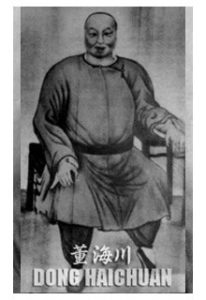
The most recognized master of Baguazhang and acknowledged as founder is Dong Haichuan, born 13th October, 1797 in the Zhujiacun, Wenán County, Hebei Province. Whilst his younger life was not entirely clear it is thought that he had interests in martial arts from a young age practicing styles within his village such as Bafan Quan (obtained from his elder cousin, Dong Xianzhou) and Luohan Boxing. There is also a story that at age twelve he studied Liuhe Quan with a Master Li (some believe it to be Li Guanming). After gaining quite prowess Dong is said to have travelled far and wide seeking out capable masters.
It was on the Jiuhua mountains in Anhui province (sometimes thought as further south in Jiangxi province, (some consider the influence to be possibly the Bafa of Zimenquan) he found a master who passed advanced boxing techniques to Dong Haichuan. It is likely that Dong was involved with members or ex-members of the Bagua Jiao faction which by then had dispersed and operated much more in secret. Some conspiracies exist that perceive Dong to have attempted to enter the royal palace with the aim of gaining insights or even assasinating royal family members.
The Manchurians who rules the Qing dynasty were proud military experts and Emperor would often invite capable masters to teach his special forces, secruity personnel and sometimes members of the Royal family. During those periods masters also had the chance to enhance their sklills amongst each other thus further developing the martial arts. When Dong Haichuan was in Bejing he managed to be hired as a servant to the family of King Su (brother of the Emperor), who also loved martial arts and had invited many masters. Sha Huizi was the supervisor of the King Su and one of the best masters, King Su’s wife was also thought to be talented.
During a royal gathering most of the servants had troubles to manage through the crowds but Dong Haichuan smoothly walked between the guests with ease. The King noticed that and asked if Dong knew martial arts and after affirming so was asked to demonstrate in the courtyard. Dong Haichuan then performed some Luohan boxing sets and the king was not impressed exclaiming that Dong must know some other skills. Dong later performed odd turns and maginficent palm methods combined with spiralling body projecting power through the back and out through the hands. When the King asked the name of this method, Dong Haichuan responded with Bagua (accordance to the sect but also the Bagua common to Chinese Daoism and the Yijing) Zhang (for the palm based methods.
After that occasion Dong was promoted as a member of the security team, but Sha Huizi had despised Dong’s skills and he requested to challenge Dong. During the challenge Sha Huizi fought with powerful killer blows aiming to hurt Dong who patiently was able to evade and neutralize all of his ferocious attacks. There were many chances for Dong to counter but he did not, yet Sha realized he was not Dong’s equal and relinquished the fight. When the King replaced Sha with Dong as the head of the security guards this made Sha even more upset and vengeful.
Within the King’s palace Dong was able to practice his martial arts and research its techniques greatly. He also would meet other great masters there such as Yang Luchan (杨露禅 1799-1872), Guo Yunshen (郭云深 1829-1900), Liu Qilan (1819-1889) and Song Mailun (1890). Dong worked for the King for over 20 years and during that time he did not teach much and was inaccessible to general students. After retirement he did teach and had a great number of disciples including Yin Fu, Cheng Tinghua, Song Changrong, Song Yongxiang, Ma Weiqi, Liu Dekuan, Liu Fengchun, Shi Jidong, Wei Ji, Liang Zhenpu, Wang Lide, Li Cunyi, Zhang Zhankui, Geng Chengxin, Zhou Mingtai and others.
When Dong taught he leveraged the primary skills of the disciples and enhanced it with Baguazhang, this resulted in a number of variations amongst his disciples so that almost everyone of them started a specific style or branch of Baguazhang. In fact much of the development of Baguazhang was undertaken by his disciples and latter generations. Dong Haichuan is today respected as the founding father of Baguazhang.
Dong Haichuan when teaching Baguazhang favored students with a previous background and in most cases taught them the principles and some key techniques of Baguazhang but the rest was from the student’s own experiences and background. As a result there are an endless number of interpretations to Baguazhang. To make it more complicated exchanges with Xingyi Quan practitioners influenced both styles in different ways and in latter generations masters from different schools would exchange or learn from one another and across styles. The result is that today Baguazhang is a comprehensive martial art with many different approaches.
Dong Haichuan had a great number of students such as Yin Fu, MWeiqi, Shi Jidong, Cheng Tinghua, Song Chang Rong, Shun Tian Zhang, Liu Dengke, Jiao Yu Long, Gu Yushan, Ma Cun Zhi, Zhang Jun, Qin Xi Kuan, Liu Dian Jia, Lu Chengde, An Fen, Xia Mingde, Geng Yong Shan, Wei Ji Xiang, Xi Zhang, Wang Xinsheng, Wang Huai Qing, Shen Chang Shou, Wang Deyi, Zhu Zhi Yun, Song Yong Xiang, Li Wan You, Fan Zhi Yong, Song Long Hai, Wang Yong Tai, Peng Lian Gui, Fu Zhen Hai, Wang Hong Bin, Gu Bu Yun, Chen Chun Lin, Wang Ting Ju, Shuang Fu, Li Chang Sheng, Xu Zhao Xiang, Liu Baozhen, Liang Zhen Pu, Zhang Ying Shan, Guo Yu Ting, Zhao Yun Xiang,,Zhang Jinkui, Jiao Chunfang, Liu Feng Chun (1853-1922), Si Yuan Gong, Qing Shan, He Wu, He Liu, Guo Tong Hai, Xu He Nian, Feng Guang Lian, Li Shou Nian, Chen Jin. The disciples or associates of Dong Hai Chuan with the greatest influence include the following key Masters, who in fact contributed much to the development of Baguazhang into what it has become today.
Yin Style Baguazhang

Yin Fu (尹福 1841-1911) Was a highly skilled martial artist known for his Snake Tongue striking style. He was also a wholesaler of baked goods and sold bread to Prince Su’s palace where Dong lived, he knew of Dong Haichuan’s skill and would ask the guards everyday if he could meet him. Yin Fu persistently asked everyday until a new guard, who knew Yin Fu because of his martial skills, passed the word along to Dong Haichuan. Finally Yin Fu was allowed into the palace to see him. Dong was sitting at a table drinking tea when Yin fu walked up and said he’d like to study with him. (Which in Chinese is a polite way to challenge someone to a fight.) Dong Haichuan at first refused, knowing that Yin Fu was no match for him but with persuasion from the Prince who had been watching, he eventually agreed. Dong told Yin to attack him and that he’d be countering with a Unicorn strike. Yin shot out a snake tongue strike for Dong’s face.
Dong still sitting down countered and then and poked out Yin Fu’s two front teeth. So as not to lose face Yin Fu swallowed his own teeth. (This is said to be the reason why he always had a large mustache.) Yin recognizing that he had been thoroughly beaten asked Dong if he could be his student. Dong refused but the prince had liked Yin Fu’s character and insisted that Dong take him on as his student. Yin Fu became Dong Haichuan’s first student and learned Dong Haichuan’s system of Bagua Zhang as well as learning Dong’s style of Lohan Fist. They spent roughly six years in the palace practicing everyday, then the Prince asked Dong to take Yin Fu with him to the north to collect taxes where it was in Dong’s best interests to have and to teach Yin Fu. In Beijing Yin Fu became well known and the Bagua that he taught became known as Yin Style Bagua. He became a bodyguard for the wealthy and powerful as well as teaching in the Imperial Palace. Outside of the Palace he started the Yin Family school. His key inheritors include: Ma Gui, Li Yong Qing, Men Bao Zhen, Cui Zhendong, Gong Baotian, Yin Cheng Zhang (3rd son) and Yin Yu Zhang (4th son).
Cheng Style Baguazhang
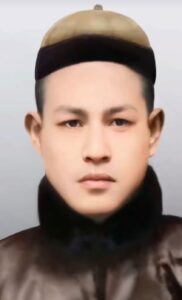
Cheng Tinghua (程廷华, 1848-1900) was the founder of Cheng Style Baguazhang. He was also known as Yingrong. He was from Cheng Family Village in Shen County, Hebei. In his youth he practiced Shuaijiao (wresting) and later he went to the capital to fourth disciple to study with Dong Haichuan after being recommended by Yin Fu and Shi Jidong (elder disciples of Dong Hiachuan). After his studies were completed, he opened an eyeglasses shop in Beijing outside the Suiwen Gate. Therefore everyone called him ‘Eyeglasses Cheng.
He was recognized widely in the martial community as a person of extraordinary abilities. After Dong Haichuan died, Cheng Tinghua, based on what he learned of the basics of the palm forms, together with his thorough understanding of the principles, created his own routines with his own special features to make Cheng Style Baguazhang. He taught many students causing his style to spread far and wide. In the 26th year of Qing Guangxu (1900), on August 14th, Cheng Tinghua, met with disaster outside the Suiwen Gate, when the 8 Army Alliance troops shot and killed him. He was 52 years old. Famous disciples of Cheng Tinghua were Cheng Yougong (Cheng Tinghua’s nephew), Cheng Youlong (Cheng Tinghua’s eldest son), Cheng Youxin (Cheng Tinghua’s second son), Li Wenbiao, Zhang Yukui, Feng Junyi, Kan Linfeng, Zhang Yongde, Zhou Xiang, Guo Tongde, Sun Lutang, Yang Mingshan and Liu Bin.
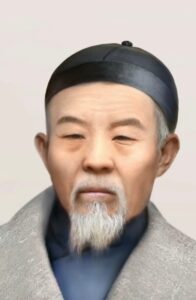
Cheng Dianhua (程殿华, 1849-1935), also called Lao Tian, was fourth brother of the Cheng family (Cheng Tinghua was third) and also a student of Dong Haichuan achieving a commendable level of skill as well. After bringing his brother’s corpse back home, he did not leave the village. He took Cheng Tinghua’s son Cheng Youxin to the ancestral home in Shen county, Hebei province. They brought the Cheng Style Martial Skills back to their native place, so often this style is called Village Baguazhang. Cheng Dianhua was largely to become responsible for the core system of Cheng Family Baguazhang. His skills with the Zhanshen Qiang (Battle Body Spear) was held in great regard.
His main disciples included Cheng Yousheng (his son), Liu Ziyang, Liu Dachen, Hu Kuohai and Geng Dayang. Cheng Yousheng (程有生), was Cheng Dianhua’s fourth son. His students were Sun Zhijun, Zhang Baozhong and others. Cheng Youxin, also nicknamed “Cuo Ye” (short uncle because of his height specailized in the lower basin palm. In his old age he was living in Louzizhuang. Cheng Style Baguazhang when practiced is like a swimming dragon that doesn’t stop, of the clouds flying in the sky or of a flowing water stream. It looks like a ferocious tiger when moving, yet it looks likea mountain when it stops. It is firm but not stagnant, soft but not feeble. There are many techniques like dodge, stretch, advance and retreat, twist, wrap, drill, roll, push, hold, lead, pull, buckle, cut and block, circle over circle.
Shi Style Baguazhang
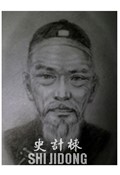
Shi Jidong (史计栋, 1837-1909), styled Shi Zhenbang, was from Xiaozhai village in Ji county in Hebei. Because he was the sixth child in his family, people called him Shi Liu (six).In his youth, he studied tantui with the famous master, ‘Iron legs’ Qin Fengyi. In just a few years, he learnt the whole art from M Qin. Later on, Yin Fu started studying under M Qin, which is how Shi and Yin became friends. After M Qin’s death, Yin became Dong Haichuan’s disciple. When Shi found out, he also bowed to Dong as his master. Because Yin had entered the door earlier, he was Dong’s senior disciple, with Ma Weiqi second and Shi Jidong third. His ‘bagua name’ was Shi Liqing.
Shi was dedicated and painstaking in his training, training year-round whatever the weather, and habitually walked the circle with his knees bent so that his buttocks were lower than his knees. He often trained until beads of sweat poured off him. He was a skilled fighter, especially his leg attacks, which were almost impossible to anticipate. Other martial artists gave him the nickname ‘zei tui Shi liu’ (sneaky legs Shi Six) and his kungfu brothers all admired his skill. Dong was fond of Shi too, and took Shi’s wife as his adopted daughter. In Dong’s old age, Shi took Dong into his home and looked after him personally. M Dong treated him like his own son-in-law. M Dong was moved by Shi’s devotion and passed on his art unreservedly.
Amongst his Beijing disciples, the more well-known were Han Fushun, Zhang Dexiu (aka Zhang Shanting), Yu Qingjin, Yang Rongben, Shou Shan, etc. M Shi’s bagua was called ‘East City bagua’ because he lived in the east of Beijing. In terms of palm shape, the characteristic palm shape of Shi style bagua is the ‘sickle’ palm, with the index and middle fingers held together, the ‘tiger’s mouth’ [the gap between the thumb and index finger] held open and the other two fingers are slightly twisted inwards. The stepping consists of ‘tang ni bu’ [mud-wading step] and the ‘chicken step’. After M Dong’s passing, Shi organised his funeral and erected a stele to commemorate him.
Liu Style Baguazhang
Liu Baozhen (刘宝珍, 1861-1922) , also known as Pingqing was from Guán county, Hebei Province. He practiced martial arts since youth and was a pracitioner of Chuojiao, his skills were of high calibre. He worked in the Shuntian palance and was known for the strength of his legs, which is where his expertise led people to call him “Flying Legs Liu”. The story goes that Dong Haichuan heard of Liu Baozhen’s skills and disguised himself to search for Liu in Guán. Liu was talented but he also had a generous and cheerful disposition. After finding Liu, they exchanged techniques and Dong was able to neutralize all of Liu’s bagua methods and chuojiao kicks after which Liu became Dong’s disciple imparting the complete Baguazhang system to Liu Baozhen.
Liu later combined his previous knowledge and experiences to enhance the Baguazhang system, creating the Bagua Jiugong Zhang (Zhuanhuan Baguazhang). He said to have also exchanged with a fellow Dong Haichuan disciple, Fan Zhiyong (some suggest Li Zhenqing) before learning from Dong Haichuan. For example he studied the Qimen principles to develop battle arrays and escaping methods, he also adopted the Chuojiao Saber to develop the Bagua’s Long Saber methods. In his later years after murdering a bandit leader, he became fairly spiritual and focused on the study of the Yiqing and other traditional philosophies. As a result he had few inheritors but those included his son who passed away early in his 30’s, Guo Mengshen (1890-1973) and his cousin Xiao Haibo (1863-1954) and Ren Zhicheng(1878-1976) from Beidouli Zhuang, Wen’an County. (It is suggested that Ren Zhicheng also studied from Li Zhenqing).
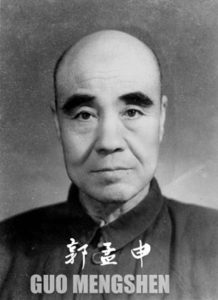
Guo Mengshen (郭孟申,1890-1973), also known as Guo Ziping was from Guán county, Hebei Province. At 12 years of age, he became an apprentice of M Liu Baozhen studying Ba Zhuang, Ba Shi, Baguazhang and Bagua Yezhan Bafang Saber. When M Guo was 26 years old, he also travelled to nearby Xincheng county, where he studied Xingyi Quan with M Ma Yutang (disciple of Li Cunyi) alongside Zhu Guofu, Gao Zhendong, and Ma’s son Ma Yuanji. When M Guo was 30 years old, together with his brothers Zhu Guofu and Ma Yuanji, he entered the Nanjing Guoshu Institute. There he was able to further advance his skills following teachers such as Yang Chengfu (Yang Style Taijiquan) and from Zhang Zhaokui, he further learnt the Bagua Spear, Bagua Staff, Bagua Sword and Bagua Yue. Whilst in the Nanjing Guoshu Institute, M Guo became known as “Fast Hands Guo” and based on his previous studies and experiences developed Bagua Sanshou Zhang taught there.
Guo taught a number of practitioners that later became well known. In Chengdu, M Wang Shutian and in Harbin M Liu Zhiqing were both taught their Baguazhang and/or Bagua Sabers by Guo Mengshen. Guo’s son, M Guo Zhenya became his key inheritor and renowned as the Bagua Saber King.
Lu Style Baguazhang
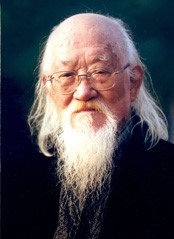
Lu Zijian (吕紫剑, 1893-2012) was born in Yichang, Hubei province. He had studied his family martial arts since young and later became an apprentice of Jiang Ying in the Chinese Medicine clinic. GM Lu is said to have studied martial arts in his with local experts Li Guocao and Jiang Ying, under which became an apprentice in Chinese medicine. Then with Li Changye (Baguazhang) , Dong Shirong (Xingyiquan) and Xu Benshan (Wudang Longmen Boxing). After being involved in a number of altercations throughout the country during the times of war and calamity, M Lu developed his experiences advancing his Baguazhang and medical skills. In 1979 he settled in Chongqing, where he established a medical clinic and taught martial arts as well which later became the Zijian Martial Arts Institute.
Lu’s Baguazhang is also known as Swimming Body Baguazhang applying the principles of the Bagua trigram directions and the three planes. There are eight variations consisting of eight palm methods, amounting to 64 palms. Gm Lu’s martial arts also include different Nei Gong practices, Dragon Palm Baguazhang and the Fire Dragon Palms. He is also known for his double ringed large sabers and other esoteric weapons of Baguazhang. He would go on to receive multiple awards and positions. Recognized officially as a Baguazhang successor and as the 9th (highest level) of government ranking, Chairman of the Chongqing Chinese Medicine Association, Chongqing Hubei Martial Arts Alliance President, Sichuan Province Martial Arts Association President, Wudang Martial Arts Federation Honorary President. Known as the Great Knight of the Yangtze river. GM Lu Zijian had a number of children (youngest born in 1915) including four daughters (Lu Jianping, Lu Jianqing, Lu Mengyue, Lu Mengxue and a son (Lu Fabin), some of his daughters practiced martial arts. GM Lu had a number of disciples, may often were already masters in their own right seeking to further develop there skills and understanding. His fellow Yichang resident, M Xia Minghua had graduated from the Chengdu Sports Institute having learnt from many well known masters, later becoming one of GM Lu’s key disciples.
Taiping Baguazhang
Taiping Baguazhang includes the practice of techniques from a stationary until a dynamic perspective. It integrates a number of Baguazhang family styles that we have studied over the years including Liu (Baozhen), Yin, Cheng and Lu (Zijian) style variations into a comprehensive system of Baguazhang.
| Ba Zhuang Gong Fa (Stationary Palm Methods) 荚马桩 Squeeze the horse posture 推山桩 Push the mountain posture 缠身桩 Wrap the body posture 拧穿桩 Twist and pierce posture 下掖桩 Lower thrusting posture 双拍桩 Double slapping the body posture 翻身桩 Turn the body posture 提筋桩 Lift the tendons/sinews posture | Ba Da Zhang Fa (Eight Great Palm Methods) 松沉式 Relax and sink 推山式 Push the mountain 抱球式 Embrace the ball 茶壶式 Tea pot 金钟式Golden Needles 猴形式 Monkey shape 探爪式 Extending the claws 眼观式 Looking and observing | Ba Gua Zhuan Zhang (Turning Palms) 下沉掌 Sinking palms 双托掌 topple up palms 合抱掌 Embracing palms 七星掌 Seven Star palms 双撞掌 Double Bump palms 阴阳掌 Yin Yang Palms 外开掌 External opening palms 推转掌 Push turning palms |
Ba Xing Gong Fa (Eight Dynamic Stepping Methods)
The most important foundation practice is in Baguazhang are based on circle walking, this includes the practice of the Tangni Bu (mud stepping) and the Kou-Bai Bu (inwards and outwards) steps. It is in the practice of Zhuang Zhang that the primary Ding Zhang (stationary palms) are practiced with circular transitions, allowing for the mastery of the stepping and turning requirements of Baguazhang.
Whilst Baguazhang is most well known for its circular stepping, in actual combat many other stepping methods are critical to its effectiveness. These core eight stepping methods are the basis for other variations and ensure a good foundation. Within these stepping methods the eight greath palms (Ba Da Zhang) and eight great postures (Ba Da Shi) can be practiced. The stepping approach includes small stepping (Xiao Caibu), mud stepping (Tangni Bu) and crane stepping (hexing Bu). Some of the foundation stepping patterns include Zhixian Bu (直线步 Straight stepping), Zou Zhuan Bu (走转步 Circular stepping), Long Xing Bu (龙行步 Dragon stepping), Bafang Bu (八方步 8 Directions Stepping), Sanjiao Bu (三角步 3 angled stepping), Yinyang Yu (阴阳鱼 Zig zag stepping), Shexing Bu (蛇行步 Snake Stepping) and Qixing Bu (七星步 Seven stars stepping).
Lianhuan Lianfa
The basic techniques are practiced through a set of linked movements such as:
Lianhuan Ba Zhang (连环掌 Eight Palms)
Lianhuan Ba Zhou (连环肘 Eight Elbows)
Lianhuan Ba Chui (连环捶 Eight Strikes)
Lianhuan Ba Tui (连环腿 Eight Kicks).
Cheng Style Ba Da Mu Zhang (八大母掌)
The Old Eight Palms (Lao Ba Zhang) of Cheng Style Baguazhang are also called the Eight Big Mother Palms (Ba Da Mu Zhang) which are: Single Change, Double Change, Flowing Posture, Behind the Body, Turning Body, Grinding Body, Overturning Body, and Returning Body as taught by GM Sun Zhijun. Lianhuan Zhang (连环掌) is the practice of the mother plams as being mutually linked and strung together and the swimming dragon set is its variation. This is the essence of Baguazhang.
- Lao Ba Da Zhang (老八大母掌 Old Eight Great Mother Palms in 126 steps)
- Lianhuan Mu Zhang (连环母掌 Continuous Mother Palms in 64 postures)
- Lianhuan Baghuazhang
Youshen Baguazhang (游身八卦掌)
This set of Baguazhang was the essence of the Bagua system as practiced by GM Lu Zijian. With an emphass on techniques such as Great python overturns his body (大蟒翻身), Grey Dragon Rolling over the river (乌龙翻江), Hidden Flower under the leaf (夜底藏花) and Sparrow drilling into the sky (鷂子鉆天). There are sixty four movements arranged within eight main palms:
- Xunshi Zhang (顺势掌 Smooth Posture Palm)
- Beishen Zhang (背身掌 Back Body Palm)
- Tanshen Zhang (探身掌 Leaning Body Palm)
- Shuangdou Zhang (双抖掌 Double Shaking Palm)
- Mopan Zhang (磨盘掌 Grinding Palm)
- Zhuanshen Zhang (轉身掌 Turning Body Palm)
- Pigua Zhang (劈挂掌 Axe Hanging Palm)
- Shuanghuan Zhang (雙換掌 Double Change Palm )
Bagua Lianhuan Zhang (八卦连环掌)
The Continuous Palms of Baguazhang consists of 64 palms (or techniques) which emphasizes the traditional features of Baguazhang, such as advanced coiling, turning and the variations of Chuan Zhang. This practice developed by Li Junfeng and Ge Chunyan, combined the essence of different families of Baguazhang which included those from Masters Li Ziming, Liu Jingru, Sun Zhijun and Sha Guozheng. Due to the importance of coiling, turning and spiraling, we often nickname it as Panlong (Coiling Dragon) continuous palms.
The Lianhuanzhang includes traditional techniques such as Tuishan Ruhai (推山入海 Topple the mountain into the sea), Baishe Tuxin (白蛇吐信 White Snake expels poison), Yaozi Zuantian (鹞子钻天Sparrow drills into the sky ), Damang Fanshen (大蟒翻身,Great python overturns it’s body) and Shizi Gunqiu (狮子滚球, Lion rolls the ball) as examples within the 64 palms.
Cheng Style Sixty Four Palms (二十四式六十四掌 24 methods, 64 Palms)
This set of palms was passed on by GM. Sun Zhijun, often considered the essence of Cheng Style Baguazhang it is one of the most beautifully constructed yet practical for combat sets of practice which emphasizes the circular principles of Baguazhang. It is the essence of the Cheng Style Baguazhang.
| 乌龙翻江 Grey Dragon Rolling over the river 青龙转身 Green Dragon Turning Body 乌龙摆尾 Grey Dragon Swinging Tail 藏花插掌 Hidden Flower Thrusting palm 撩陰翻身 Overturn the body 抽身換影 Recoil the body to exchange the shadow 掩手阴阳 Covering hand Yinyang palms 獅子滾球 Lion rolling over the ball | 轉身雙扑 Turn Body Double pouncing 转身撞搓 Turn bump and grind palm 云片橫削 Cutting a piece of Cloud 烏龍絞柱 Grey Dragon wraps the column 转身云龙 Turn Body Cloud Dragon 反背錘 Behind the Back Fist 夜叉探海 Yecha demon travels in the ocean 蓋身 Cover the body | 搖身 Shake the body 轉身掖掌 Tucking in palm 游身穿掌 Swimming body 青龍探爪 Green dragon stretches claws 旋風穿掌 Tornado Thrust palms 海底撈月 Pick moonlight from bottom of the sea 鷂子鉆天 Sparrow drilling into the sky 燕子抄水 Sparrow skips over water |
Taiyi Huolong Zhang (太乙火龙掌 Taiyi Fire Dragon Palm)
This special boxing set was compiled by GM Lu Zijian, comprising of both martial techniques from other styles as well as Baguazhang. That is, it can be practiced slowly for health and in a more combat orientation aligned to the principles of Baguazhang. GM Lu Zijian used to explain that when practiced it should wave smoothly like a leaf falling towards the ground.
Yin Style Bagua Liushisi Zhang (尹氏八卦六十四掌 Yin Style Bagua 64 Palms)
This very long set of Baguazhang contains many techniques. It was taught by Cao Zongsheng via Zhang Jinchen’s disciple Sun Shuxue. There are eight sections with eight sequences therein each. This is the essence of Yin Style Baguazhang.
Liu Style Jiu Gong Zhang (刘氏八卦九宫掌 Nine Palace Palms) The Nine palace palms are also known as the ”Kuai Shou (Fast)’ methods and the ‘Sanshou (Combat). This is the advanced set of Liu Style Baguazhang’
Bagua weapons adhere to the same principles as the empty hand techniques. Whilst there are specialized Bagua weapons, in some cases the methods were adopted from other styles. A few of these practices are vary rare and were almost considered lost.
- Yezhan Bafang Dao (夜战八方刀 Night Fighting Eight Directions Saber)
- Bamian Zhanshen Qiang (八面战身枪 Eight facing Battle Body Spear)
- Qixing Bang (七星杆 Seven Star Stick)
- Jiuhuan Shuang Dao (九环双刀 9 Rings Double Broadswords)
- Panguan Bi (判官笔 Judge’s pen)
- Shuangtou Qiang (五虎穿林双头枪 Five Tigers Through the forest Two headed Spear)
- Ziwu Yuanyang Yue (子午鸳鸯钺 Ziwu Deer Horn Knives)
- Bagua Jian (八卦龙形剑 8 Trigrams Dragon Shape Sword)
- Litang Ji (八卦六趟戟 8 Trigrams Halberd)
- Ziwu JiZhao Yinyang Rui (子午鸡爪阴阳锐 Ziwu Chicken Claw Yinyang Piercers)
Dual Practice
As another element of practice the dual combat sets are practiced in addition to the general combat training.
- Baguazhang Duilian (八卦掌对练 Dual Combat Baguazhang)
- Bagua Dui Dao (八卦刀对练 Dual Combat Saber)
Battle Formation Methods
Qimen Jiugong Jun (奇门九宫八阵 Mysterious Battle Array formations )
This practice is based on the traditional Daoist Qimen Dunjia concepts of the eight battle formations integrating with the essence of Daoist universal mechanisms including eight trigrams, five elements, seven stars and nine palaces into its practice. These include Fang Zhen, Yuan Zhen, Pin Zhen, Mu Zhen and so on.
